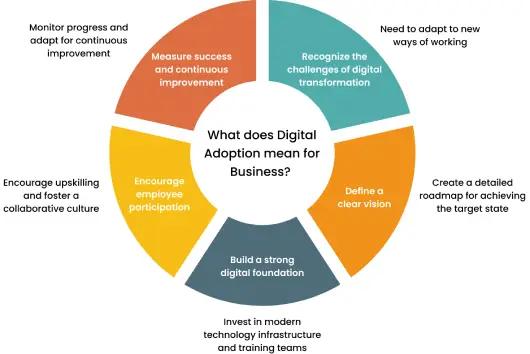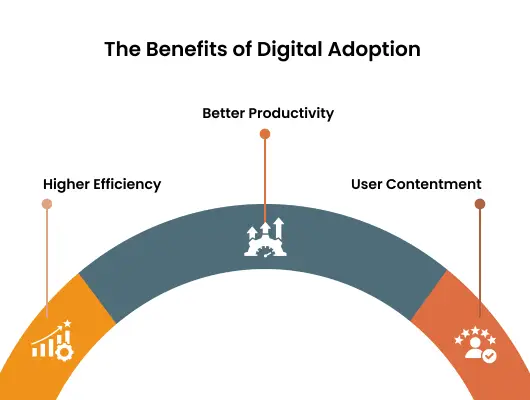What is Digital Adoption?
Digital Adoption is the process by which individuals and organizations switch from using traditional methods to fully integrating and using digital tools and technologies. The idea entails a significant change in the way that technology is adopted to improve business operations, going beyond mere usage.
It primarily focuses on making sure that users are proficient and comfortable with the new tools. Whereas, Digital Transformation covers the strategy of accepting modern technology in general.
What makes Digital Adoption Crucial for Businesses?
Today’s fast-paced world demands businesses to operate seamlessly, where employees are equipped with the latest advanced technology so they can be as productive and efficient as ever. This isn’t a distant future, it’s digital adoption.
It is an essential component in the modern business world where technological advancement occurs at an incredible speed. It’s an important factor that determines whether a company succeeds or fails.
Businesses that effectively use digital adoption tools are more agile, competitive and better positioned to respond to changing market and customer demands.
According to Gartner, 67% of market leaders beat their competitors because of their advanced digital adoption strategies in place. Read out to know what Gartner says.
It is the key component of modern business strategy since it facilitates employee onboarding, increases productivity, innovates, and streamlines processes.
See How Assima Can Help You Become a Proactive Force That Delivers Business Results
What does Digital Adoption mean for Business?
Businesses these days are transitioning from traditional Change Management and Learning and Development methodologies to a more complex Digital Adoption Strategy. This combines research into how your colleagues operate within the business and the systems used to deliver on the business objectives. Defining the right strategy requires several key steps:
- Recognize the challenges of digital transformation
Digital transformation is often challenging due to resistance from employees, lack of necessary skills, and the need to adapt to new ways of working.
- Define a clear vision
Digital transformation must begin with a clear, defined mission and vision statement. Leaders should define clear digital transformation goals, identify critical initiatives, and create a detailed roadmap for achieving the target state.

- Build a strong digital foundation
To succeed in digital transformation, organizations must build a strong digital foundation. This involves investing in modern technology infrastructure, training existing teams, and implementing robust data security measures. These steps support digital initiatives and ensure transformation success.
- Encourage employee participation
Encouraging employee participation is a key factor in the success of digital transformation initiatives. Here are some ways to encourage employee participation. Encourage upskilling, recognize and reward contributions, and foster a collaborative culture to support digital transformation.
- Measure success and continuous improvement
Measuring success and continuous improvement are critical elements of a successful digital transformation strategy. Here are some key factors to consider when measuring success and driving continuous improvement.
Establish clear KPIs aligned with organizational goals. Monitor progress and adapt as needed for continuous improvement.
The Benefits of Digital Adoption
Higher Efficiency
The considerable boost in efficiency that comes with Digital Adoption is amongst its most important benefits. Routine tasks can be automated with the help of digital tools which can streamline operations and cut down on human errors. Hence, frees up important time and resources.
For instance, the Sales team can focus on establishing relations and closing deals with the help of Customer-Relationship Management (CRM) systems. It can automate data entry and follow-up emails.
Better Productivity
Employee productivity increases when they have the appropriate digital tools and the knowledge to use them efficiently. Data analytics solutions, project management software and collaboration platforms help teams work more efficiently and swiftly to reach choices. Eventually, this results in better performance and higher profits.
User Contentment
Digital Adoption increases user satisfaction as it streamlines and optimizes tasks. When employees are educated and confident, they are less likely to become frustrated at work while using the tools. Such positive experiences extend to customers, who benefit from faster and more efficient service.

The Common Challenges of Digital Adoption
Digital Adoption comes with many challenges despite its various benefits. Here’re a few listed below:
Resistance to Change
Change can be daunting and due to the fear of the unknown or concern about their ability to adapt to technology, employees resist new technologies. This can be mitigated through effective change management strategies that involve clear communication, employee engagement and demonstrating the tangible benefits of new software.
Inadequate Training
One of the biggest challenges of Digital Adoption is lack of training. Employee dissatisfaction and less productivity could result in their inability to use new software and technologies successfully without the right training. Therefore, comprehensive training programs tailored to the requirements of users are important for successful Digital Adoption.
Technical Difficulties
Digital Adoption might be hampered by technical obstacles like compatibility and software bugs. Maintaining a seamless adoption process depends on quickly resolving these issues with IT assistance and ongoing monitoring.
Assima’s Digital Adoption Platform
Assima Digital Adoption Platform (DAP) is a complete solution designed to speed up the adoption process. It offers a wide range of digital adoption tools and features to support users in their digital journey. Let’s look at how three Assima solutions: Assima Assist, Assima Train, and Assima In-app Search, combined together make up for the perfect Digital Adoption Platform.
Assima Assist is a real-time, context-sensitive help digital adoption solution that guides users through their digital tasks. By providing immediate, in-the-moment support, Assima Assist reduces the learning curve associated with new technologies and minimizes user frustration. It offers:
- Real-Time Guidance
- Context-Sensitive Help
- Reduced Support Costs
Assima Train is a comprehensive system training platform designed to equip users with the skills and knowledge required to use new digital tools successfully. This Digital Adoption Platform offers an immersive and engaging learning experience that ensures users are well-prepared for digital adoption. It helps users with:
- Interactive Training Modules
- Customizable Content
- Continuous Assessment
Assima In-app Search is a powerful search tool that allows users to find information and resources without leaving their current application. It enhances productivity by providing quick access to the knowledge users need to perform their tasks effectively with:
- Integrated Search Functionality
- Comprehensive Knowledge Base
- Enhanced User Experience
Conclusion
Digital Adoption is a vital component for businesses’ success in today’s digital world. Businesses can utilize digital tools by realizing their significance, tackling usual problems and implementing effective strategies. Focusing on it not only enhances efficiency and productivity but also ensures that organizations remain competitive and innovative.
With the right Digital Adoption tools and strategies, your organization can turn the promise of digital transformation into a reality, transforming how you operate and setting the stage for sustained success in the digital age.
Frequently Asked Questions
Let’s Answer Some of Your Questions.
The process by which users incorporate new digital technologies into their workflows to increase productivity and efficiency is known as "digital adoption." It involves making optimal use of these technologies to attain desired goals.
On the other hand, the term "digital transformation" refers to a bigger idea that includes the entire strategy of integrating digital technologies into every aspect of an organization, radically altering how it functions and provides value to clients.
By empowering employees to use digital tools more efficiently, digital adoption can dramatically increase customer satisfaction by producing quicker reaction times, more accurate information, and a more seamless customer experience. For instance, CRM system-savvy customer care agents can get customer histories fast, respond to queries more rapidly, and offer individualized support.
Effective management and leadership are essential to the success of the digital adoption process. They oversee establishing the goals, fostering a positive environment, and supplying the tools required for adoption initiatives. Setting clear expectations, leading by example, and emphasizing the value of digital adoption are all characteristics of effective leaders. Along with this, training employees and assisting them is crucial.
It can be effectively implemented through the following methods:
Start Small
Focus first on one or two primary areas where digital adoption tools can make the biggest difference, then gradually extend from there.
Training Employee
Ensure that all employees are proficient and at ease with the new tools by investing in training programs.
Seek Guidance
To acquire insights and best practices from other businesses that have successfully implemented digital tools or consult with digital adoption experts.
Monitoring Progress
Evaluate and review the results of digital adoption programs on a regular basis, and make changes as needed to ensure continued success and improve results.
The following KPIs can assess the effectiveness of digital adoption initiatives, including:
- Variations in productivity levels including the amount of time needed to finish a task or the quantity finished in a given amount of time.
- Increase in process effectiveness, including lower error rates or more efficient work processes.
- Feedback from employees about their impressions and contentment with the new technologies.
- Increases brought about by better service delivery in terms of ratings and feedback from customers.
- Financial measurements such as return on investment (ROI) evaluate the revenue and cost reductions associated with digital adoption. Calculate your ROI with Assima
Success Stories
Get insights from our case studies, each highlighting the positive impact of technology on modern businesses:
CHU Montpellier
CHU Montpellier Replaced 3 hours of classroom training by 40...
Read MoreGlobal Airline
Global Airline Saves over £630,000 by optimizing training flights
Read More

